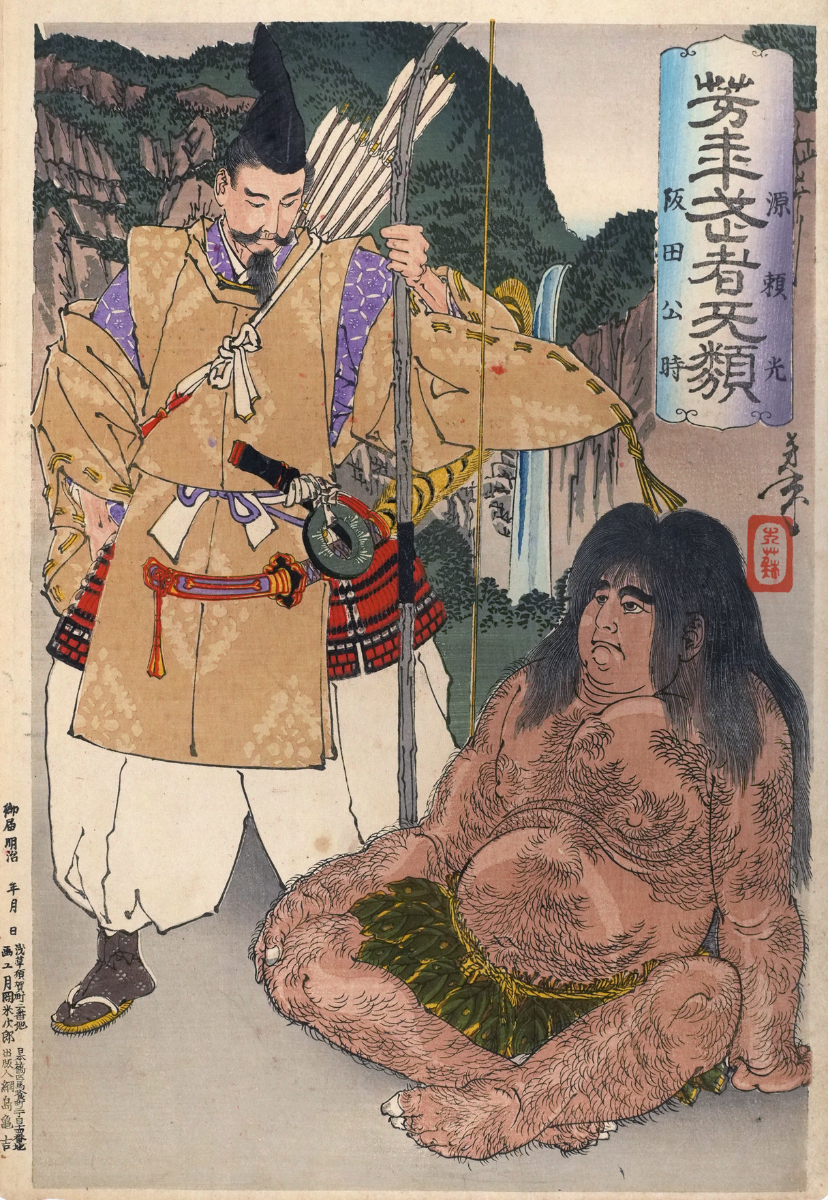Minamoto no Yorimitsu (948 – August 29, 1021), also known as Minamoto no Raikō, was a Japanese samurai of the Heian period, who served the regents of the Fujiwara clan along with his brother Yorinobu, taking the violent measures the Fujiwara were themselves unable to take. He is one of the earliest Minamoto of historical note for his military exploits, and is known for quelling the bandits of Ōeyama. Yorimitsu is usually accompanied by his four legendary retainers, known as the Shitennō (The Four Heavenly Kings). They were Watanabe no Tsuna, Sakata no Kintoki, Urabe no Suetake, and Usui Sadamitsu. Yorimitsu is featured in a number of legends and tales, including the legend of Kintarō (Golden Boy a.k.a. Sakata no Kintoki), the legend of Shuten Dōji, and the legend of Tsuchigumo. The tachi (long sword) “Dōjigiri” owned by Tokyo National Museum and selected as a National Treasure and Tenka-Goken (“Five Swords under Heaven”), and “Onikirimaru” owned by Tada Shrine, have a legend that Yorimitsu beheaded Shuten Dōji. Also, three swords of the same name, “Hizamaru” owned by Daikaku-ji Temple, Hakone Shrine and an individual, have a legend that Yorimitsu beat off Tsuchigumo. According to John Stevenson in Yoshitoshi’s Thirty-Six Ghosts (1983), “Raiko is associated with a large number of ‘demon-quelling’ exploits… A vixen had taken up residence in the rafters of the imperial palace, causing a great deal of alarm with its scratching around to find a comfortable bed. Raiko was a good archer and shot and killed it. As reward, he was commissioned to rid the capital and its surroundings of the robbers and bandits whose numbers had recently grown out of control.”
| Alias Minamoto no Yorimitsu (源 頼光) |
| Real Names/Alt Names Minamoto no Yorimitsu (源 頼光), Minamoto no Raikō |
| Characteristics Archer, Monster Hunter, Samurai, Historical Figures, Medieval Age, Japanese |
| Creators/Key Contributors Tsukioka Yoshitoshi, ○ |
| First Appearance Historical figure (b. 948 – d. 1021) |
| First Publisher ○ |
| Appearance List Konjaku Monogatari-shū (c. 1120), Ōeyama Ekotoba (14th c.) — illustrated tale of Shuten-dōji’s defeat, Otogi Zōshi: Shuten-dōji (15th c.), Uji Shūi Monogatari (13th c.), Legend in Japanese Art (1908) — Henri L. Joly art-historical survey |
| Sample Read The Taiheiki: a Chronicle of Medieval Japan (Translated 1959) [Internet Archive] |
| Description Minamoto no Yorimitsu (948 – August 29, 1021), also known as Minamoto no Raikō, was a Japanese samurai of the Heian period, who served the regents of the Fujiwara clan along with his brother Yorinobu, taking the violent measures the Fujiwara were themselves unable to take. He is one of the earliest Minamoto of historical note for his military exploits, and is known for quelling the bandits of Ōeyama. Yorimitsu is usually accompanied by his four legendary retainers, known as the Shitennō (The Four Heavenly Kings). They were Watanabe no Tsuna, Sakata no Kintoki, Urabe no Suetake, and Usui Sadamitsu. Yorimitsu is featured in a number of legends and tales, including the legend of Kintarō (Golden Boy a.k.a. Sakata no Kintoki), the legend of Shuten Dōji, and the legend of Tsuchigumo. The tachi (long sword) “Dōjigiri” owned by Tokyo National Museum and selected as a National Treasure and Tenka-Goken (“Five Swords under Heaven”), and “Onikirimaru” owned by Tada Shrine, have a legend that Yorimitsu beheaded Shuten Dōji. Also, three swords of the same name, “Hizamaru” owned by Daikaku-ji Temple, Hakone Shrine and an individual, have a legend that Yorimitsu beat off Tsuchigumo. According to John Stevenson in Yoshitoshi’s Thirty-Six Ghosts (1983), “Raiko is associated with a large number of ‘demon-quelling’ exploits… A vixen had taken up residence in the rafters of the imperial palace, causing a great deal of alarm with its scratching around to find a comfortable bed. Raiko was a good archer and shot and killed it. As reward, he was commissioned to rid the capital and its surroundings of the robbers and bandits whose numbers had recently grown out of control.” |
| Source Minamoto no Yorimitsu – Wikipedia |


